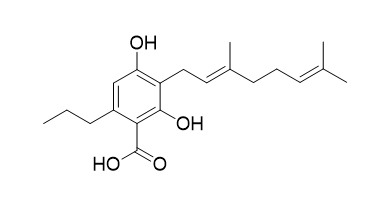Cannabigerovarinic acid
Cannabigerovarinic acid(CBGVA) may contribute to the effects of cannabis-based products in childhood epilepsy.
Inquire / Order:
manager@chemfaces.com
Technical Inquiries:
service@chemfaces.com
Tel:
+86-27-84237783
Fax:
+86-27-84254680
Address:
1 Building, No. 83, CheCheng Rd., Wuhan Economic and Technological Development Zone, Wuhan, Hubei 430056, PRC
Providing storage is as stated on the product vial and the vial is kept tightly sealed, the product can be stored for up to
24 months(2-8C).
Wherever possible, you should prepare and use solutions on the same day. However, if you need to make up stock solutions in advance, we recommend that you store the solution as aliquots in tightly sealed vials at -20C. Generally, these will be useable for up to two weeks. Before use, and prior to opening the vial we recommend that you allow your product to equilibrate to room temperature for at least 1 hour.
Need more advice on solubility, usage and handling? Please email to: service@chemfaces.com
The packaging of the product may have turned upside down during transportation, resulting in the natural compounds adhering to the neck or cap of the vial. take the vial out of its packaging and gently shake to let the compounds fall to the bottom of the vial. for liquid products, centrifuge at 200-500 RPM to gather the liquid at the bottom of the vial. try to avoid loss or contamination during handling.
Int J Mol Sci.2019, 21(1):E265
Biomol Ther (Seoul).2020, 28(6):542-548.
Molecules. 2013, 18(11):14105-21
Int J Biol Macromol.2020, 161:1230-1239.
Int J Mol Sci.2020, 21(22):8816.
Univerzita Karlova2022, 173245.
Heliyon.2022, 8(12):e12031.
Front Pharmacol.2021, 12:765521.
Phytochem Anal.2013, 24(5):493-503
Saudi Pharmaceutical Journal2023, 31(12):101829
Related and Featured Products
Br J Pharmacol . 2021 Dec;178(24):4826-4841.
Cannabigerolic acid, a major biosynthetic precursor molecule in cannabis, exhibits divergent effects on seizures in mouse models of epilepsy[Pubmed:
34384142]
Background and purpose: Cannabis has been used to treat epilepsy for millennia, with such use validated by regulatory approval of cannabidiol (CBD) for Dravet syndrome. Unregulated artisanal cannabis-based products used to treat children with intractable epilepsies often contain relatively low doses of CBD but are enriched in other phytocannabinoids. This raises the possibility that other cannabis constituents might have anticonvulsant properties.
Experimental approach: We used the Scn1a mouse model of Dravet syndrome to investigate the cannabis plant for phytocannabinoids with anticonvulsant effects against hyperthermia-induced seizures. The most promising, cannabigerolic acid (CBGA), was further examined against spontaneous seizures and survival in Scn1a mice and in electroshock seizure models. Pharmacological effects of CBGA were surveyed across multiple drug targets. +/-+/-
Key results: The initial screen identified three phytocannabinoids with novel anticonvulsant properties: CBGA, cannabidivarinic acid (CBDVA) and Cannabigerovarinic acid (CBGVA). CBGA was most potent and potentiated the anticonvulsant effects of clobazam against hyperthermia-induced and spontaneous seizures, and was anticonvulsant in the MES threshold test. However, CBGA was proconvulsant in the 6-Hz threshold test and a high dose increased spontaneous seizure frequency in Scn1a mice. CBGA was found to interact with numerous epilepsy-relevant targets including GPR55, TRPV1 channels and GABA+/-A receptors.
Conclusion and implications: These results suggest that CBGA, CBDVA and CBGVA may contribute to the effects of cannabis-based products in childhood epilepsy. Although these phytocannabinoids have anticonvulsant potential and could be lead compounds for drug development programmes, several liabilities would need to be overcome before CBD is superseded by another in this class.
J Nat Prod. 2019 Nov 22;82(11):3047-3055.
Pharmacokinetics of Phytocannabinoid Acids and Anticonvulsant Effect of Cannabidiolic Acid in a Mouse Model of Dravet Syndrome[Pubmed:
31686510]
Cannabis sativa produces a complex mixture of many bioactive molecules including terpenophenolic compounds known as phytocannabinoids. Phytocannabinoids come in neutral forms (e.g., Δ9-tetrahydrocannabinol, THC; cannabidiol, CBD; etc.) or as acid precursors, which are dominant in the plant (e.g., Δ9-tetrahydrocannabinolic acid, THCA; cannabidiolic acid, CBDA; etc.). There is increasing interest in unlocking the therapeutic applications of the phytocannabinoid acids; however, the present understanding of the basic pharmacology of phytocannabinoid acids is limited. Herein the brain and plasma pharmacokinetic profiles of CBDA, THCA, cannabichromenic acid (CBCA), cannabidivarinic acid (CBDVA), cannabigerolic acid (CBGA), and Cannabigerovarinic acid (CBGVA) were examined following intraperitoneal administration in mice. Next it was examined whether CBDA was anticonvulsant in a mouse model of Dravet syndrome (Scn1aRX/+ mice). All the phytocannabinoid acids investigated were rapidly absorbed with plasma tmax values of between 15 and 45 min and had relatively short half-lives (<4 h). The brain-plasma ratios for the acids were very low at ≤0.04. However, when CBDA was administered in an alternate Tween 80-based vehicle, it exhibited a brain-plasma ratio of 1.9. The anticonvulsant potential of CBDA was examined using this vehicle, and it was found that CBDA significantly increased the temperature threshold at which the Scn1aRX/+ mice had a generalized tonic-clonic seizure.



